

Current degree day accumulations
Orchard radar apple insect key dates
Location: UMass Cold Spring Orchard, Belchertown, MA
27-May, 2013 |
|
| Base 43 | 594 |
| Base 50 | 363 |
| Coming events | Degree days (Base 43) |
| Black cherry fruit fly first catch | 702-934 |
| Codling moth 1st flight peak | 571-999 |
| European red mite 1st summer eggs | 447-555 |
| European red mite summer eggs hatch | 737-923 |
| Lesser peachtree borer 1st catch | 485-683 |
| Oblique-banded leafroller pupae present | 601-821 |
| Redbanded leafroller 1st flight subsides | 589-899 |
| Spotted tentiform leafminer sap feeders present | 343-601 |
| Spotted tentiform leafminer 1st flight subsides | 674-956 |
Here are insect key insect dates from Orchard Radar, Belchertown, MA.
Codling moth (CM) 1st generation, first sustained trap catch biofix date: May 16, Thursday. Codling moth development as of May 28: 1st generation adult emergence at 15% and 1st generation egg hatch at 0%. In most orchards, insecticide targetted against plum curculio and apple maggot prevent codling moth damage.
Obliquebanded Leafroller (OBLR) 1st generation OBLR flight begins around: June 8, Saturday. Where waiting to sample late instar OBLR larvae is not an option (= where OBLR is known to be a problem, and will be managed with insecticide against young larvae): Early egg hatch and optimum date for initial application of B.t., Delegate, Proclaim, Intrepid, Rimon, Altacor, Belt, pyrethroid or other insecticide effective against OBLR (with follow-up applications as needed): June 25, Tuesday.
Oriental Fruit Moth (OFM) 1st generation OFM flight starts: May 3, Friday. 1st generation 55% egg hatch and first treatment date, if needed: May 30, Thursday.
Plum curculio (PC) increased risk of PC damage as McIntosh and similar cultivars increase fruit size: May 22, Wednesday. Earliest safe date for last PC insecticide spray: May 31, Friday. If relying on repellance by Surround instead of PC mortality by insecticide, Surround coverage should be maintained until PC egglaying begins to naturally decline around Saturday, June 29.
Spotted Tentiform Leafminer (STLM) 1st generation sapfeeding mines start showing: May 20, Monday. Optimum sample date is around Wednesday, May 22, when a larger portion of the mines are visible.
European Red Mite (ERM) Optimum monitoring period for 1st generation ERM: Saturday, May 18 (Petal Fall) to Thursday, May 23 (early adults ready to lay eggs for 2nd generation)
http://extension.umass.edu/fruitadvisor/upcoming-events
Primary on everyone's mind this week should be applying a chemical thinner where additional thinning is needed. It should be a very good time to apply a chemical thinner, i.e., it should work. If modest thinning is desired, a single application of carbaryl (Sevin @1-2 pint per acre), NAA (Fruitone-L @ 2-6 oz. per acre), or 6-BA (Maxcel @ 2 quart per acre) is indicated. If more thinning is desired, use a combination of most any two of above. CAUTION: temperatures above 85-90 degrees F. can result in over-thinning! Use caution when applying growth regulators such as NAA or 6-BA when the forecast is hot! (Particularly 6-BA, i.e. Maxcel.) Carbaryl is safer at these temperatures. See more on thinning under horticulture. Good luck, this will be your one best chance to get it right.
If applying petal fall or 1st cover sprays for plum curculio to apple blocks, Oriental fruit moth (OFM) should be covered. Otherwise, see the NEWA output below and the 2013 New England Tree Fruit Management Guide for more specific OFM control recommendations.
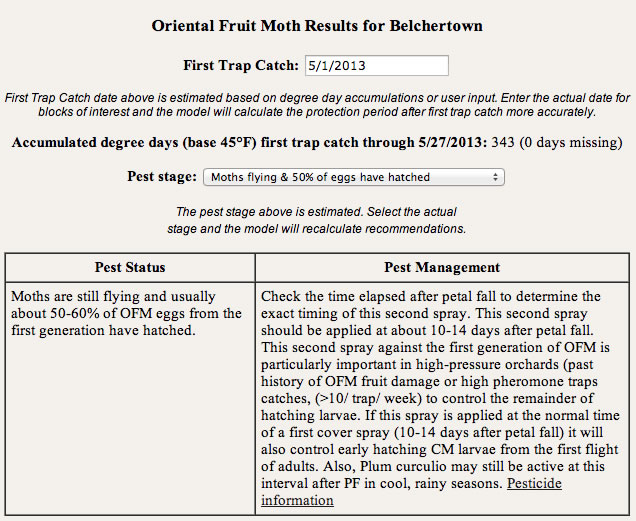
If CM is a problem in your orchard, now is the time to apply insecticide sprays. See the 2013 New England Tree Fruit Management Guide for specific recommendations, however, Alatacor, Assail, Belt, Calypso, Delegate, Imidan, Lannate, Leverage, and Voliam Express EC are banner CM control insecticides.

Plum curculio (PC) are still very active and will be increasingly so as the weather warms this week. At 99 DD's, we are about one-third of the way to 308 DD's when control measures will no longer be needed. Below is the current NEWA status. Needless to say, insecticide coverage is necessary beginning NOW until the risk of damage is over. Actara, Avaunt, Calypso, Imidan, Leverage, and Voliam Express EC all have good-excellent efficacy. Note that a full rate of Sevin used for thinning, at least 2 quarts per acre, will give fair curculio protection.
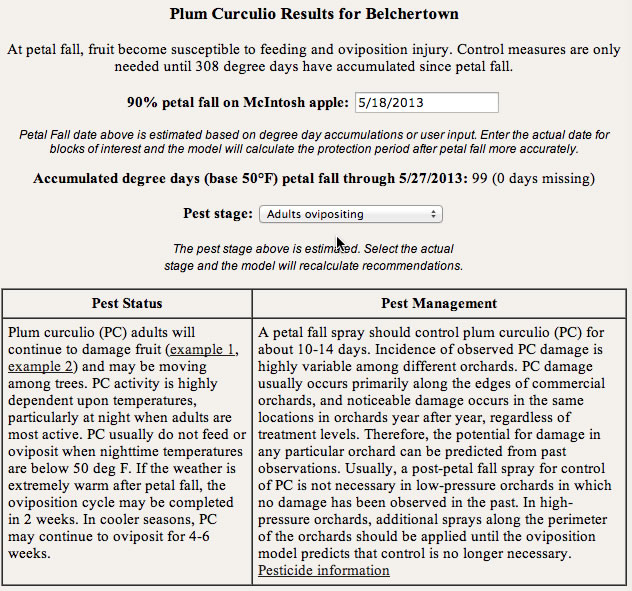
Petal fall sprays also control oblique-banded leafroller OBLR (to a certain extent). Below is the current NEWA output and discussion for OBLR. As of today (5/28) we have caught no OBLR moths in pheromone traps at the UMass Orchard
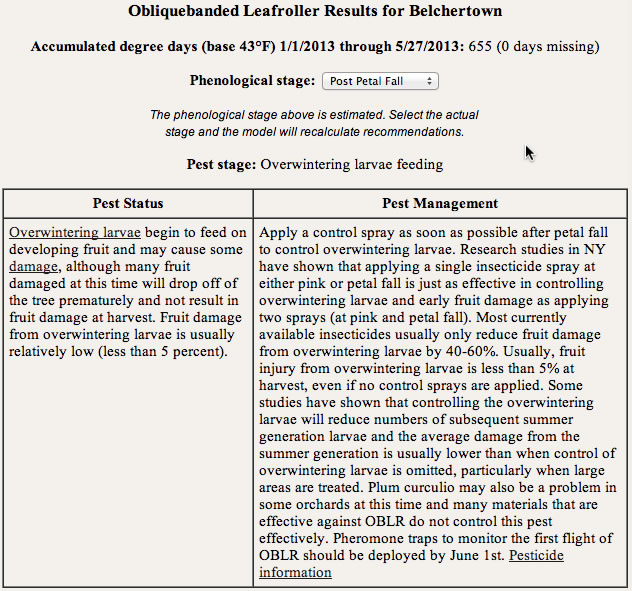
Spotted tentiform leafminer (STLM) are quiet right now, but if you have a perpetual problem with STLM then you should have pheromone traps up to monitor the second flight per the NEWA output below.

Regarding apple scab, indeed there was a major infection period beginning mid-week last week and more-or-less continuning through last Saturday. Below is the current NEWA output indicating ascopore maturity is at 99%.
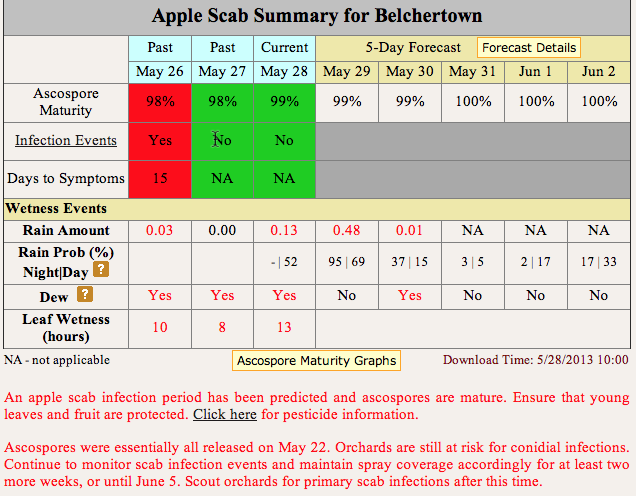
Regarding ascospore maturity -- I have access to several sources of data, and here is where they currently stand for Belchertown:
NEWA: 99%
SkyBit E-Weather: 97%
Orchard Radar: app. 90%, as high as app. 98% and as low as app. 75%
RimPRO: app. 90%
There is likely to be one more scab infection period with rain tonight and tomorrow. Some orchards may be adequately protected with fungicide and will be all done. For most, however, I would consider being coverd up for this infection period (or right after if you believe in using kick-back fungicides) and then we will be done with primary scab season. Continue to monitor your foliage for signs of infection and if you have a perpetual problem with scab, you will probably want to remain covered up with fungicide for another two weeks during rainy weather.
There will be a high risk of fire blight infection towards the end of this week, but only if you have open bloom (pretty well gone now) or you have a trauma event (such as hail and/or high wind with precipitation during a thunderstorm) to the foliage. I would be interested to hear any reports of fire blight strikes starting to show up as we should be seeing them soon from earlier infection periods.
OK, I commented on apple fruit thinning above. Again, I have access to several sources of thinning information regarding efficacy at application based on the weather forecasts. Based on these, and my gut feeling, you will get good thinning at modest rates because of the upcoming heat. I repeat, and go ahead, if you need modest thinning, a single application of carbaryl (Sevin @1-2 pint per acre), NAA (Fruitone-L @ 2-4 oz. per acre), or 6-BA (Maxcel @ 1.5 to 2 quart per acre) is indicated. If more thinning is desired, use a combination of most any two of above. You will get good thinning now and you should thin if you need to! But, use some CAUTION: temperatures above 85-90 degrees F. can result in over-thinning! Use caution when applying growth regulators such as NAA or 6-BA when the forecast is hot! (Particularly 6-BA, i.e. Maxcel.)
!!!Just in!!! This is from Jim Schupp, Penn State University Fruit Times and after some discussion with Duane Greene, he too thinks it is good advice!
Caution
The forecast for our region calls for temperatures in the high 80s to low 90s for Wednesday through Sunday, with lows in the mid-60s throughout that time. Under high temperatures, all thinning chemistries are more effective than when temperatures are more moderate. This includes carbaryl, regarded by many as a mild thinner. Under high heat, even carbaryl can be a potent thinner, removing larger fruits that would be expected.
If chemical thinning is still needed, you should apply thinners, however the forecast dictates that this is a time to tread lightly. Chemical rates should be reduced to the minimum effective dose for the variety being treated. Carbaryl should be applied at 1 pt per 100 gallons of spray mix. Re-think the need for oils or other adjuvants in the thinner tank mix. Do not concentrate chemical thinners in such weather, even if you are spraying concentrate.
Finally, if you determine that the best course of action is to wait and apply a thinner spray containing ethephon, you may still have time to wait for the coming hot spell to pass to make a chemical thinning application.
Below is the result of the NEWA Apple Carbohydrate model run today (5/28) for Belchertown. It's indicates a modest carbohydrate deficit beginning right now and suggests reducing rates slighly by 15%. Note that this model output changes daily and really should be updated every day for the station closest to you. The NEWA Apple Carbohydrate model website is here: http://newa.cornell.edu/index.php?page=apple-thin

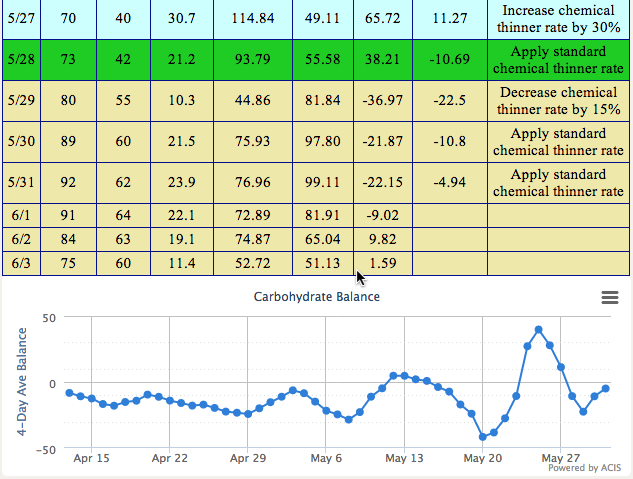
UMass Fruit Advisor: http://umassfruit.com
Scaffolds Fruit Journal: http://www.nysaes.cornell.edu/ent/scafolds/
Network for Environment and Weather Applications (NEWA): http://newa.cornell.edu
Follow me on Twitter (http://twitter.com/jmcextman) and Facebook (http://www.facebook.com/jmcextman)
UMass Vegetable & Fruit IPM Network (on Facebook, http://www.facebook.com/umassipmteam)
The next Healthy Fruit will be published on Tuesday, June 4 or thereabouts, 2013. As always feel free to get in touch with any member of the UMass Fruit Team (http://extension.umass.edu/fruitadvisor/team-members) if you have questions or comments.